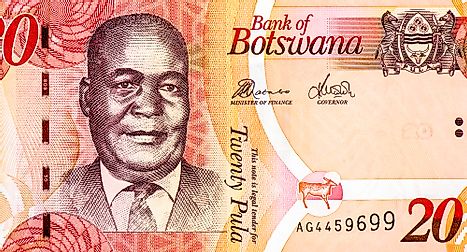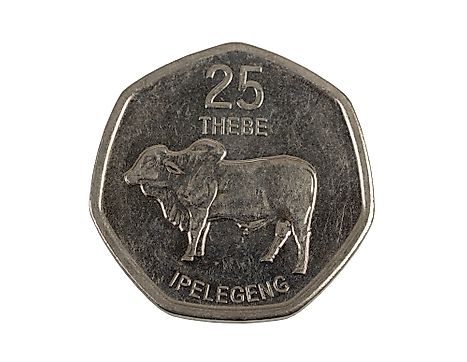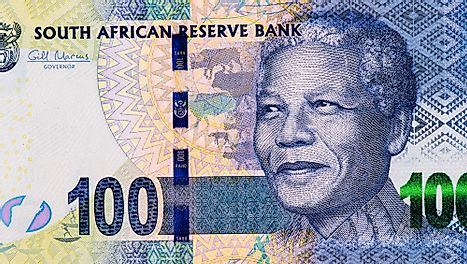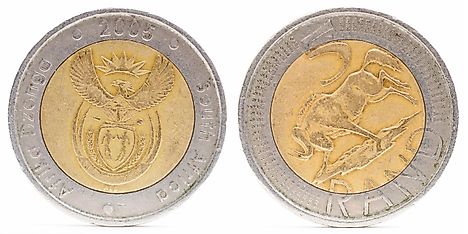Flags, Symbols & Currency of Botswana
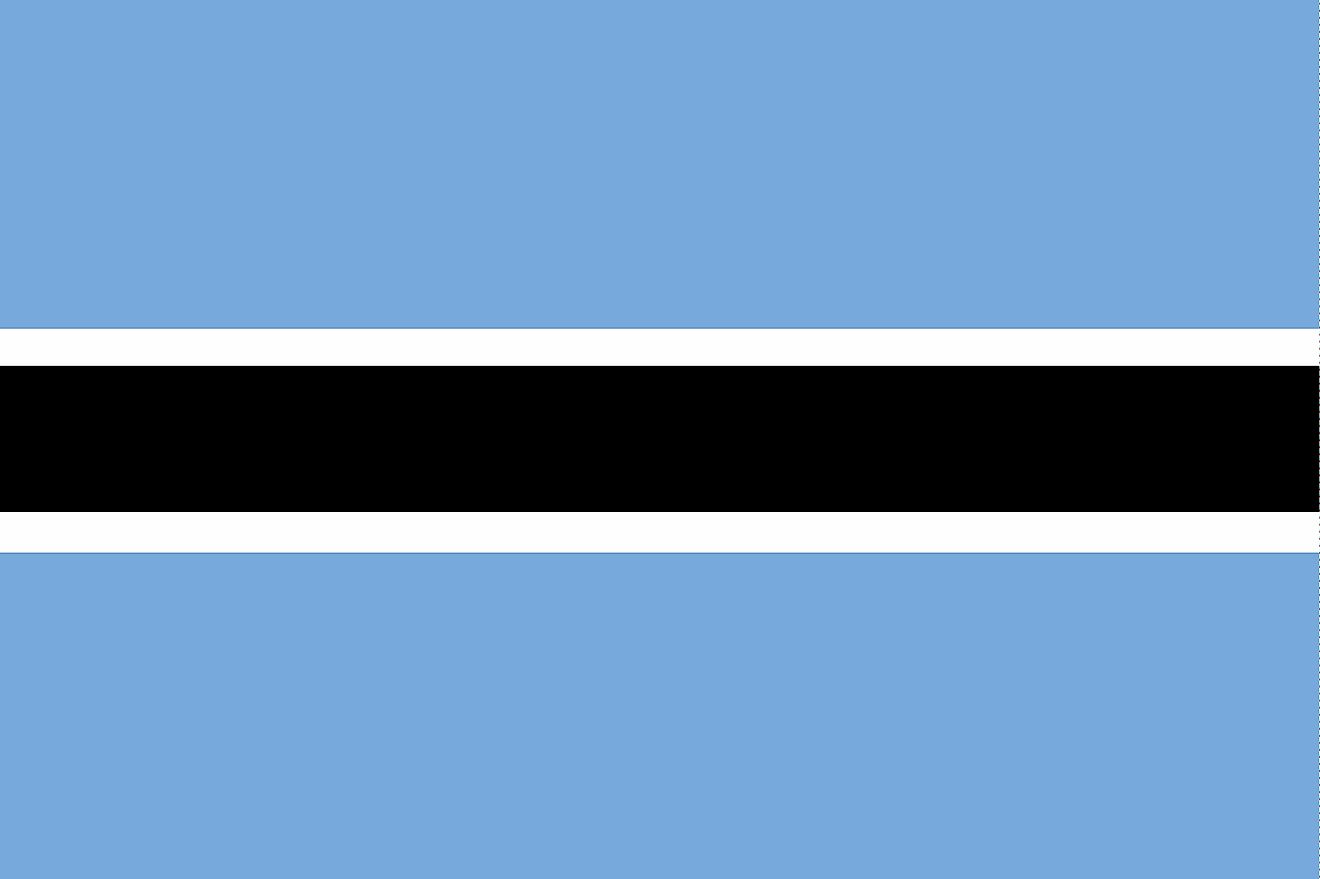
The Botswana flag was officially adopted on September 30, 1966.
The national flag of Botswana features light blue, black, and white horizontal bands of varying thicknesses. Thick light blue bands are featured at the top and bottom of the flag, followed by thin white bands and a horizontal white-edged black stripe in the center. The colors on the flag correspond to those on the national coat of arms; and every color chosen on the flag has social, administrative, and local significance. The light shade of the blue color represents water – a vital supply for an agricultural country like Botswana and also represents life, which depends on water. The water is obtained from rain, although Botswana experiences a frequent lack of rainfall and water is thus a scarce and precious commodity in the vast Kalahari Desert. The black and white colors symbolize accord and collaboration amongst the people of diverse races and cultures living in Botswana, as well as the pluralist nature of the society. It also represents the stripes of a zebra, which is considered a symbol of natural abundance and is Botswana's national animal. The flag has a width-to-length proportion ratio of 2:3.
History of the Flag of Botswana
Botswana was named Bechuanaland before its independence in 1966. In 1885, Bechuanaland became a British colonial territory. Bechuanaland became colonized after the Tswana people entered into an agreement with the British for protection against the Boers of South Africa, thus becoming a protectorate. The Boers wanted Bechuanaland to join the union of South Africa, which was made up of the Cape, Natal, Transvaal, and Orange River colonies that had unified although they were formally separate colonies. Despite entering into a contract with the British, the Boers pressured the British for Bechuanaland to join their union. The Boers' demand was opposed by Botswana until Bechuanaland gained independence from Britain in 1966. Botswana gained independence from the United Kingdom in 1966 and adopted the new flag that year as a replacement for the Union Jack that had been imposed to demonstrate British colonial rule. The flag of Botswana was raised for the first time on September 30, 1966, which is Botswana’s Independence Day.
Botswana is among a limited number of countries that did not include red, green, and yellow on its flag, which are the colors of the Pan-African movement that tried to unite the people of Africa. The flag was intended to be distinguished from the South African flag since South Africa was governed by a system of division according to skin color and origin. Hence, the black bars and white borders were included, representing the peace and accord between the blacks and whites residing in Botswana.
Symbols of Botswana
The National Coat of Arms of Botswana
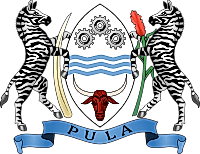
Botswana's coat of arms was adopted on January 25, 1966, and is based on the designs by Isabel Fawcus. It contains a central shield supported by two zebras. The zebras symbolize the importance of wildlife, through tourism in the national economy. The black and white stripes of the zebra represent the equality of all people of all colors in Botswana. The zebra on the left holds onto a tusk of ivory - symbolic of the former ivory trade. The zebra on the right holds an ear of sorghum - an important crop to the nation. Within the shield are three cogwheels representing industry, three waves symbolizing water, and the head of a bull to depict the importance of cattle herding in Botswana. The national motto "Pula" connoting rain, hope, and confidence in the future, is displayed on a blue ribbon placed at the bottom of the coat of arms. The blue color of the coat of arms hints at the guiding principle and also highlights the importance of water to Botswana.
National Motto:
Pula ("Rain")
National Anthem
- Anthem Title: "Fatshe leno la rona" ("Blessed Be This Noble Land")
- Music Composer: Kgalemang Tumediso Motsete
- Lyricist: Kgalemang Tumediso Motsete
- Date of Adoption: 1966
The national anthem of the Republic of Botswana is "Fatshe leno la rona" ("Blessed Be This Noble Land"). The anthem has been composed and authored by Kgalemang Tumediso Motsete. It was officially adopted as the national anthem of Botswana in 1966, when the country became independent.
Fatshe leno la rona (Setswana)
First Verse:
Fatshe leno la rona
Ke mpho ya Modimo,
Ke boswa jwa borraetsho;
A le nne ka kagiso.
Chorus:
Tsogang, tsogang! Banna, tsogang!
Emang, basadi, emang, tlhagafalang!
Re kopane le go direla
Lefatshe la rona.
Second Verse:
'Ina lentle la tumo
La tšhaba ya Botswana,
Ka kutlwano le kagisano,
E bopagantswe mmogo.
Chorus:
Tsogang, tsogang! Banna, tsogang!
Emang, basadi, emang, tlhagafalang!
Re kopane le go direla
Lefatshe la rona.
Blessed Be This Noble Land
First Verse:
This land of ours,
Is a gift from God,
An inheritance from our forefathers;
May it always be at peace.
Chorus:
Awake, awake, O men, awake!
Arise, O women, arise! be energized,
Let us work together to serve,
Our land.
Second Verse:
Beautiful name of fame
Of the nation of Botswana,
Through harmonious relations and reconciliation,
Bound together.
Chorus:
Awake, awake, O men, awake!
Arise, O women, arise! be energized,
Let us work together to serve,
Our land.
The Currency of Botswana is the Pula
The official currency of Botswana is Pula. The literal meaning of Pula is rain, and the currency's name came about since there is scarce rainfall in Botswana. Therefore, the money is as valuable as the rain and is also a blessing just like rain.
The sub-units of the currency are expressed as thebe which means "shield". The Pula is divided into 100 thebe. It is rated as one of the strongest currencies in Africa.
Coins
During the introduction of Pula in 1976, coin denominations were 1, 5, 10, 25, and 50 thebe as well as 1 Pula. Aluminum was used in the one thebe coins while the 5 thebe coins were made of bronze. All the coins were round except the 1 Pula coin which had a scalloped shape. In 1981, the dodecagonal two thebe coins were introduced though, after 1985, their use was stopped. The replacement of the five thebe bronze coins by bronze-plated steel coins occurred in 1991, together with the replacement of the 10, 25, and 50 thebe cupro-nickel coins by the nickel-plated steel coins. During the same year, there was also the transition of the 1 Pula coin to a nickel-brass coin that was smaller than the first coin. The coin also had seven sides and was an equilateral curve.
Later, in 1994, there was the introduction of the 2 Pula coin that had a similar shape as the smaller 1 Pula coin and was made of nickel-brass. The size of the 2-pula coin in 2004 was smaller than the one before, and it was steel with a brass plate. In 1998, the 1 and 2 thebe coins were removed from circulation. Consequently, the thebe coins that came into circulation were in 5, 10, 25, and 50 denominations. The 5 and 25 thebe had seven sides while the 10 and 50 coins were still round. In the year 2000, there was the introduction of a 5 Pula bimetallic coin which showed a mopane caterpillar feeding on a branch of a mopane tree. The composition of the coin was the aluminum-nickel-bronze ring above the cupronickel center. In 2013, there was the introduction of a new sequence of pula coins.
Banknotes
The introduction of Pula notes in the Bank of Botswana took place on August 23, 1976. The denominations of the notes were 1, 2, 5, and 10 pula notes. Later, on February 16, 1978, there was the introduction of the 20-pula note while in 1991 and 1994 coins replaced the 1 and 2 pula notes. The 50-pula notes came into circulation on May 29, 1990. Moreover, the 100-pula notes were issued on August 23, 1993. In 2000, a coin also replaced the 5 Pula note, and the demonetization of the 1, 2, and 5 pula notes took place on July 1, 2011.
Historical Currencies of Botswana
The original currency of Botswana was the South African Rand. The introduction of Pula in 1976 replaced the South African Rand. Banknotes were printed in denominations of 10, 5, 2, and 1 Pula. In 1978, the first 20-pula note was introduced. From 1991-1994, the 1-pula banknote and 2-pula banknotes were replaced by coins. In 2000, the 5-pula banknote was also replaced with a coin. The original banknotes were discontinued and are no longer a part of the circulation. In 2005, Pula devalued by 12%. In 2009, the latest Pula notes were introduced and the first 200-pula note was introduced. Pula is still among the strongest currencies in Africa.
